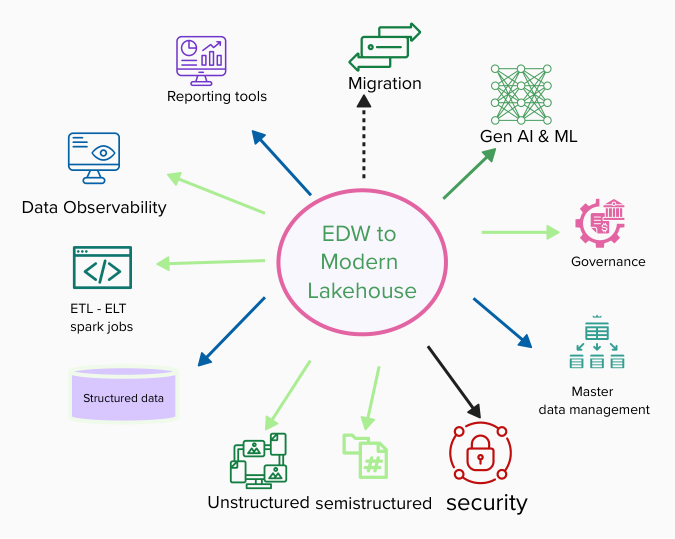What If Your Data Could Be Both Deeply Analysed and Incredibly Flexible?
Intro: Ever changing Data challenges
In today's data-driven world, organisations are drowning in information but starving for insights. Traditional data storage solutions are increasingly inadequate, struggling to keep pace with the volume, variety, and velocity of modern data. What if there was a way to transform your data from a static resource into a dynamic, intelligent asset?
EDW - Traditional and modern approach
A data warehouse, often called an enterprise data warehouse (EDW), consolidates data from various References into a unified data repository. This setup facilitates robust data analysis and machine learning. Unlike standard databases, a data warehouse empowers organisations to perform advanced analytics on extensive historical data, even at petabyte scales.
Imagine a retail company managing multiple stores. Each store's sales data, inventory updates, and client transactions are stored in separate databases for fast and secure processing. However, the operational databases fall short when the company wants to analyze overall sales trends across all stores or forecast future demand based on historical data. They aren't designed for complex analytical queries or generating reports efficiently, which is where a data warehouse steps in—a specialized system dedicated to storing data in formats optimized for reporting, visualizations, and analytical tasks.
To populate the data warehouse with information from operational databases, data engineers create data pipelines that regularly update the warehouse with fresh data (e.g., nightly updates). This process, known as ETL (extract, transform, load), ensures the warehouse contains up-to-date and transformed data ready for analysis and reporting.
While data warehouses have been integral to business intelligence for decades, they've evolved with advancements in data types and hosting methods. Traditionally on-premises, today's data warehouses may reside on dedicated appliances or in the cloud, offering enhanced analytics capabilities and visualisation tools.
Re-platforming from an On-prem Data Warehouse to a Modern Lakehouse or Embracing a Hybrid approach:
On-prem EDW + Lakehouse
Cloud EDW + Lakehouse
Lakehouse + Data Intelligence
Data Lake - Flexibility meets complexity
A data lake is a vast storage repository that stores raw data in its native format until needed for analysis. Unlike a data warehouse, which structures data for specific queries, a data lake retains diverse data types, including structured, semi-structured, and unstructured data, providing flexibility for various analytical purposes.
Consider a healthcare organization managing patient records, medical images, research data, and operational logs. These data sources generate a mix of structured data (like patient demographics), semi-structured data (such as medical notes), and unstructured data (like MRI scans). Storing all this data in a traditional database or data warehouse would be challenging due to the diverse formats and evolving data sources.
Here's where a data lake shines. It acts as a centralized repository, ingesting data from various sources without imposing a predefined structure. This setup allows data scientists, analysts, and researchers to explore and analyze data as needed without upfront data modelling constraints.
Data lakes use technologies like Hadoop, Apache Spark, and cloud-based storage solutions to handle massive volumes of data efficiently. Data engineers create pipelines to ingest, process, and organize data within the lake, making it accessible for analytics and machine learning tasks.
Data Lakehouse - The best of both worlds
A data lakehouse merges the strengths of data lakes and warehouses, providing a unified platform for storing, processing, and analyzing diverse data types, including structured and unstructured data. This unified approach seamlessly caters to operational and analytical workloads.
In a financial services scenario, a data lakehouse is a comprehensive data platform that handles vast volumes of client transactions, market data, regulatory filings, and risk assessments. It offers the flexibility to store and process diverse data types, enabling comprehensive analysis for business insights, regulatory compliance, and risk management.
EDW to Modern Lakehouse
Driving Factors and Business value
The driving factors tick many boxes, from cost savings to skills and developer community & support. Here is a list of Capabilities and features which we need to consider in terms of Architecture: Data Processing & Management, Advanced analytics and Infrastructure & Reporting Tools.
Traditionally on-premises, today's data warehouses may reside on dedicated appliances or in the cloud, offering enhanced analytics capabilities and visualisation tools. While data warehouses have been integral to business intelligence for decades, they've evolved with advancements in data types and hosting methods.
This Unified data capability enables organisations to unlock the true value of data within an organisation. A Hybrid approach of embracing Data Lake + Data warehouse helps:
IT Enterprise Architecture: Domain Ownership, Data as a product, Self-service data access, Federated governance
Business value: a potential asset as a rich data source and a hub for data processing tasks essential for exploratory data analytics.
Targeted outcome for IT organisation
Return on Investment
Increase data and AI team’s productivity
Accelerate AI projects return on investment
Cut traditional data integration costs
Reduced risk of a data breach
Improve outcomes with trusted data
Next steps,
As we stand at the intersection of data management innovation, the journey from traditional data warehouses to modern lakehouses represents more than a technological upgrade—it's a strategic transformation. In our next installment, we'll dive deeper into architectural considerations, migration strategies, and the technical nuances that can make or break your data intelligence efforts.
Next Steps and Community Invitation:
As we stand at the intersection of data management innovation, this journey from traditional data warehouses to modern lakehouses is more than a technological upgrade—it's a strategic transformation.
In our next instalment, we'll explore:
Detailed architectural considerations
Practical migration strategies
Technical nuances that can make or break your data intelligence efforts
💡 Challenge for You: What unique data challenges is your organization facing? Share your experiences in the comments, and let's collectively navigate this evolving data landscape!
Stay tuned for Part 2 of our Data Intelligence series. 🚀📊
What challenges are you facing in your current data architecture? Share your experiences in the comments below, and let's explore this evolving landscape together.
Citation
https://www.databricks.com/blog/2020/01/30/what-is-a-data-lakehouse.html
https://www.linkedin.com/pulse/lakehouse-convergence-data-warehousing-science-dr-mahendra/
https://www.ibm.com/topics/data-warehouse







